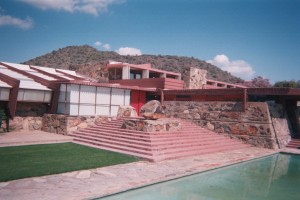Building with Nature

Originally appears in the Fall 2007 issue
Here I sit on the edge of the desert, taking in the view and the spicy scent of the lush deep-green orange groves, from the wide cool porch of Taliesin West, Frank Lloyd Wright’s desert landmark. I’m wondering if others value this place as I do. Does everyone appreciate a place in the same way? I suspect that if I were to ask my middle school students to describe the best aspects of our community, they would cite the new mall on the edge of town with its surrounding acres of steaming asphalt parking. Their preference for the mall reflects the value they place on entertainment, rather than aesthetics and community character. How can we teach them the difference, without telling them what to think or how to think?
A few years ago, searching for a way to teach about community character, I teamed with colleagues in developing an architecture unit to take advantage of Taliesin West’s being located in our community. I wondered how we could instill aesthetic values in our students so that they would be sensitive to community character as adults. How did Frank Lloyd Wright develop his ideas about “building with nature”? Did others share his values, or was he ahead of his time? How could we help our students to appreciate the unique gem that Taliesin West represents right here in our community? Should we be trying to instill our adult values for community character? How should we define community character to make it relevant to middle school students?
What started as a 9-week (90 minutes per week) architectural unit for gifted and talented students in Grades 3-8 has now become a 36-week curriculum that includes a real-world application of the skills learned. In the first of the unit’s four sections, students hone their observation skills and learn basic principles of architecture. We then take a close look at Frank Lloyd Wright’s idea of “building with nature” and its implications for community character. Finally, students evaluate buildings and visual environments in our community and engage in a variety of projects to effect change.
This content is restricted to subscribers only.
If you are not yet a subscriber, please consider taking out a subscription here.
If you are an existing subscriber, kindly log in or contact us at info@greenteacher.com for more information.





